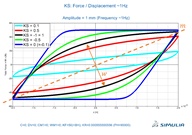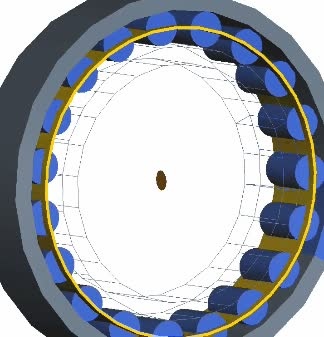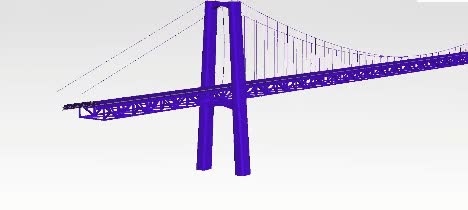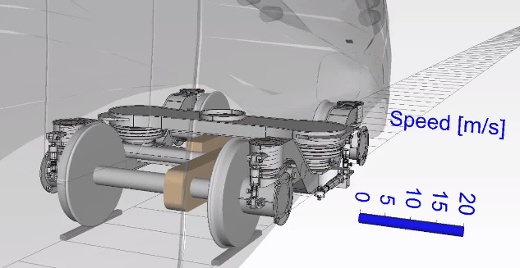Simpack Releases
Currently, the most up-to-date major version of Simpack is Simpack 2022. We encourage every current Simpack user to download and upgrade to this latest version, or at least to one of the minor releases available. Here is an overview of the most up to date releases of Simpack as of today:
- Simpack 2022.1 ( released 2021-06-18 )
- Simpack 2021x.5 ( released 2021-05-28 )
- Simpack 2021.5 ( released 2021-06-18 )
Note that Simpack 2022.2 is on the launch pad and will be officially out on Friday the 30th of July so please keep an eye at http://software.3ds.com
Recently Added Features
EHD Bearing

The Simpack EHD module has been enhanced to include thermal balance and mass conserving effects in the fluid. This allows the EHD model to compute the temperature evolution over time in the fluid, allowing to observe the heating up of the bearing. The mass conserving algorithm will help the user to analyze cavitation effects and oil flows in more detail.
Additionally, the output of this element has been extended to provide out-of-the-box results at bearing half-width.

Dynamic Bushing
The dynamic bushing force element is used to model accurately the specific frequency behavior of engine and suspension bushing mounts. With recent versions of Simpack, there has been several enhancements brought to this element:
- optional direction coupling of the bushing stiffness It is now optionally possible to specify the coupling effect between different directions of the bushing. This can be used for example to better model cylindrical bushings with isotropic or orthotropic behavior.
- Enhanced hysteresis shape definition

- We have introduced a new shape factor to refine the fitting of the shape of the hysteresis. This factor does not affect the overall amplitude of the hysteresis but gives the user control of the shape of the curve.
Electric Machine Interface

Since Simpack 2019x, Simpack supports the application of electromechanical forces with the Electric machine interface force element. This element can apply distributed forces on the stator and the rotor of the machine. It uses as an input a set of characteristic maps. A characteristic map is a map of lumped forces/torques or force densities as a function of the rotation of the rotor given at a specific speed/torque point of the e-drive machine. The interface has been extended recently to support Reduced-Order Models that can be produced by CST Studio Suite. The added value of using a Reduced Order Model (ROM) for this application is that it is possible with a ROM to run different load cases such as torque run-up or speed run-up with one single element.
Simpack Roller Bearing

Several significant enhancements have been recently added to the Simpack Roller Bearing model:
- It is now possible to apply a user-defined profile to the rollers
- The lateral distribution of the loads on the roller can now be computed. This new feature vastly extends the functionality and applications of this modeling element. Including this bearing element in complete mechanical drives, models will provide improved results for misalignment calculations.
- The contact force between the elements can now take into account optionally the damping effects due to lubrication.
Simpack Rail and Flextrack
Fast calculation of flexible track/structures

We have introduced a new method for modeling flexible tracks called “linear Flextrack”. This new method considerably reduces the model build time and dramatically improves the solver performance, considerably reducing solve time. As an example, Flexible tracks simulations can now be run in a matter of few minutes rather than hours.
Improved Rail Contact Model for Supporting Standstill

The Simpack Rail contact model has been extended to support standstill conditions as an option in the rail/wheel pair element that allows for the stick/slip transition of the rail contact at very low velocity. It is now possible with this option to model new workflows :
- emergency braking simulation
- improved static test rig set-up and analyses
- modeling real-life velocity profile of light-rail vehicles including stop/start behavior between stations.

With the Simpack Belt module, it is now possible to plot belt transverse deflections and stick-slip contours on the belt shape and other quantities such as longitudinal or normal force distributions.
This enables analysts to gain more insight into the belt behavior for typical belt analysis scenarios, allowing them to identify critical regions at first glance.
Want to learn more about Simpack and connect with other Simpack users? Visit our SIMULIA Community to discover the latest tips, to ask questions and to share your expertise. Our dedicated Simpack Learning Resources page is a great place to start exploring.
SIMULIA offers an advanced simulation product portfolio, including Abaqus, Isight, fe-safe, Tosca, Simpoe-Mold, SIMPACK, CST Studio Suite, XFlow, PowerFLOW and more. The SIMULIA Community is the place to find the latest resources for SIMULIA software and to collaborate with other users. The key that unlocks the door of innovative thinking and knowledge building, the SIMULIA Community provides you with the tools you need to expand your knowledge, whenever and wherever.